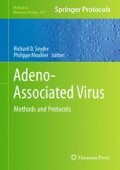Abstract
Recombinant adeno-associated virus (rAAV) vectors are capable of mediating long-term gene expression in a wide variety of animals, including primates. The rAAV genome is packaged into the virion as single-stranded DNA devoid of any viral genes. A proportion of the single-stranded genomes are converted into transcriptionally active double-stranded DNA (dsDNA) early after nuclear entry by second-strand synthesis mediated by host repair DNA polymerases or/and by annealing of the rAAV (−) and (+) strands. Second-generation, self-complementary vectors are packaged as single-strand hairpins and rapidly assume a dsDNA conformation independent of the action of polymerases. In both cases, linear dsDNA vector genomes circularize and can undergo concatemerization into higher order forms (McCarty et al. Annu Rev Genet 38: 819–845, 2004; Schultz and Chamberlain Mol Ther 16: 1189–1199, 2008; Duan et al. J Virol 72: 8568–8577, 1998). As a result, rAAV vector genomes are maintained mainly as circular monomeric and concatemeric episomal forms in skeletal muscle and liver (Schnepp et al. J Virol 77: 3495–3504, 2003; Penaud-Budloo et al. J Virol 82: 7875–7885, 2008; Nakai et al. J Virol 75: 6969–6976, 2001). Moreover, in nonhuman primate skeletal muscle, it has been shown that rAAV episomes assimilate into chromatin with a typical nucleosomal pattern that presumably is important for persistence and gene expression in quiescent tissues over a period of several years (Penaud-Budloo et al. J Virol 82: 7875–7885, 2008).
Conversely, although rAAV is not considered as an integrative vector per se, introduction of exogenous DNA into the nuclear compartment can result in low-level vector assimilation into the host genome. One mechanism appears to involve vector insertion at sites of double-strand DNA breaks using cellular DNA repair enzymes. As rAAV gene transfer technology and applications mature, a better characterization of the genetic fate of the rAAV genome is critical to accurately evaluate the risk/benefit ratio for a particular disease indication. In this chapter, two complementary methods are detailed to enable characterization of rAAV molecular structure in a particular target tissue and estimation of its integration frequency.
Access this chapter
Tax calculation will be finalised at checkout
Purchases are for personal use only
References
McCarty, D. M., Young, S. M., Jr., and Samulski, R. J. (2004) Integration of adeno-associated virus (AAV) and recombinant AAV vectors, Annu Rev Genet 38, 819–845.
Schultz, B. R., and Chamberlain, J. S. (2008) Recombinant adeno-associated virus transduction and integration, Mol Ther 16, 1189–1199.
Duan, D., Sharma, P., Yang, J., Yue, Y., Dudus, L., Zhang, Y., Fisher, K. J., and Engelhardt, J. F. (1998) Circular intermediates of recombinant adeno-associated virus have defined structural characteristics responsible for long-term episomal persistence in muscle tissue, J Virol 72, 8568–8577.
Schnepp, B. C., Clark, K. R., Klemanski, D. L., Pacak, C. A., and Johnson, P. R. (2003) Genetic fate of recombinant adeno-associated virus vector genomes in muscle, J Virol 77, 3495–3504.
Penaud-Budloo, M., Le Guiner, C., Nowrouzi, A., Toromanoff, A., Cherel, Y., Chenuaud, P., Schmidt, M., von Kalle, C., Rolling, F., Moullier, P., and Snyder, R. O. (2008) Adeno-associated virus vector genomes persist as episomal chromatin in primate muscle, J Virol 82, 7875–7885.
Nakai, H., Yant, S. R., Storm, T. A., Fuess, S., Meuse, L., and Kay, M. A. (2001) Extrachromosomal recombinant adeno-associated virus vector genomes are primarily responsible for stable liver transduction in vivo, J Virol 75, 6969–6976.
Clark, K. R., Sferra, T. J., Lo, W., Qu, G., Chen, R., and Johnson, P. R. (1999) Gene transfer into the CNS using recombinant adeno-associated virus: analysis of vector DNA forms resulting in sustained expression, J Drug Target 7, 269–283.
Southern, E. M. (1975) Long range periodicities in mouse satellite DNA, J Mol Biol 94, 51–69.
Acknowledgments
The authors thank Dr. Bruce Schnepp for optimization of the B1-PCR assay conditions and the Nationwide Children’s Hospital Viral Vector Core for rAAV vectors and cell lines used in the generation of these methods.
Author information
Authors and Affiliations
Corresponding author
Editor information
Editors and Affiliations
Rights and permissions
Copyright information
© 2012 Springer Science+Business Media, LLC
About this protocol
Cite this protocol
Clark, K.R., Penaud-Budloo, M. (2012). Evaluation of the Fate of rAAV Genomes Following In Vivo Administration. In: Snyder, R., Moullier, P. (eds) Adeno-Associated Virus. Methods in Molecular Biology, vol 807. Humana Press. https://doi.org/10.1007/978-1-61779-370-7_10
Download citation
DOI: https://doi.org/10.1007/978-1-61779-370-7_10
Published:
Publisher Name: Humana Press
Print ISBN: 978-1-61779-369-1
Online ISBN: 978-1-61779-370-7
eBook Packages: Springer Protocols

